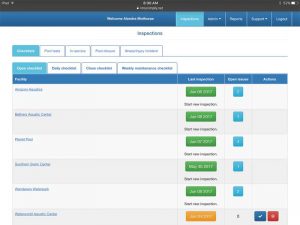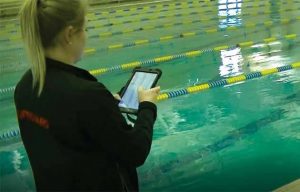How many managers know when was the last time he/she reviewed the facility’s day-to-day operational records? For some, it may be at the start of the season, while for others it could even be last year. In many cases, these records may not have been looked at since they were initially created. In fact, it is quite possible they are the same operational records that have been used for years. Documentation of maintenance issues, safety inspections, and water quality results is more important now than ever, but there are very few facilities that are as diligent as the law requires.
With more government agencies in Canada and the U.S. adopting the Model Aquatic Health Code (MAHC), there is a new industry standard to follow for pool operating procedures and best practices. The last thing a facility manager wants to worry about in the face of potential litigation or a public health crisis is if his/her aquatic team followed the proper procedures for documentation requirements. Many organizations are turning toward digital storage and processing of their records to ensure they are complete and safely stored. There are many options to consider, so facility managers need to make sure he/she not only gets what they want, but also what will keep the facility safe.
Checklists
Every facility has some sort of checklist they follow on a regular basis. These could include daily opening and closing procedures, weekly cleaning duties, or monthly maintenance items. The challenge with the current paper method is there is typically no accountability for items that need correction. For instance, safety checks are the primary method of facility surveillance.
Facility managers, lifeguards, or other staff such as those who handle facility operations and maintenance—or a combination of both—may perform these checks. If these checks are to be useful, they need to include procedures for reporting issues and following up. For instance, how often does a facility manager need to comment about the shower still leaking before maintenance comes to repair it? What if the checklists a facility manager completed every day would automatically send alerts and reminders? With a digital tool, this is not only possible, but automated.
A safety check is a quick method of assessing the condition of the facility and includes an evaluation of specific elements and areas, including communication equipment, rescue, first aid and safety equipment, operational equipment such as lifeguard stands, lane lines, bulkheads, starting blocks, pool decks, waterpark attractions, locker rooms (e.g. dressing/shower areas, restrooms), chemical storage areas, fencing, and access points.
Other items may include checklists for daily oxygen or automated external defibrillators (AEDs), diving boards or waterslides, or even concession areas. Another benefit of digital tools is the ability to customize and create new checklists as items arise that requires documentation.
In-services and trainings
Another area that is critically important to document is on-going training. Every lifeguard should meet an in-service requirement before taking the stand, but how does a facility manager ensure every single lifeguard has completed their in-service?
The in-service records should include the dates and time of the in-service, what topics were covered and who attended. With old paper records, it is hard to track attendance by person and confirm they have recently attended one. By using digital forms, a facility manager can create a dashboard that can highlight lifeguards who have met this requirement versus those who have not. With this information being readily available, staff schedules and shifts can be easily managed, while also making sure everyone on staff is complying with the training standards in place. Further, these records can be extremely handy when it comes time to conducting staff evaluations.
Pool chemicals records
One of the most regular items documented at an aquatic facility is water chemistry. These readings should be performed and recorded several times per day and even up to once or twice an hour.
Historically, these readings were written down in a notebook that was stored in the pump room. This notebook would get splashed on, have spills, may contain illegible handwriting, and even torn or missing pages. With digital documentation, the information is safely stored in the cloud for future access. Additionally, with a digital facility, managers have the added benefit of these records automatically informing him/her about any non-compliance concerns and even recommending actions for correction. These could include chemical dosage calculations or providing step-by-step instructions to remove chloramines. Digital documentation can take a facility’s chemical logs to the next level.
Pool closures
Whether it is a contamination issue (i.e. a pool fouling) or weather-related, no facility manager likes to close his/her pool. However, when action needs to be taken, facility managers need to document why they closed the pool and what actions were taken to minimize potential risks.
Depending on the reason for closure, different sets of information need to be documented. This makes it hard to create one piece of paper that can work for all situations. For example, why would a facility manager write down the last time he/she heard thunder or what time the pool was closed due to poor water quality? In these scenarios, specific forms have to be created for each reason for the closure, or blank sections need to be included on the forms.
With digital documentation, facility managers can use dynamic forms that only require information to be filled in that is relevant to the reason for closure. This information is complete and safely stored for future reference. Another benefit is the reports can be run to show the most common reason for closure, the frequency of closures by facility or timeline, and several other areas to help identify specific trends and gain insight.
Illness or injury

Documentation of maintenance issues, safety inspections, and water quality results is more important now than ever.
By having a dynamic form that allows facility managers to select the type of incident, he/she now has a flexible form that is suitable for various situations. This also allows this information to be stored and securely backed up in case any of the reports need to be referenced at a later date.
Lifeguard evaluations and certifications
After a lifeguard is initially trained, the facility is responsible for keeping up with the ongoing education and evaluations. Like in-service records, it becomes difficult to track who has been evaluated, what area they were tested on, how they scored during the last test, and so on.
For example, how does a facility manager know the lifeguard who only works on Tuesdays has had a skill review? Digital documentation helps to ensure the manager knows exactly which lifeguards have been tested and how they need to follow up with them based on his/her evaluation.
Whether the evaluation was positive or negative, every lifeguard should be well-trained and always ready to perform throughout his/her time at the facility. By using digital documentation, this information is easily tracked and viewable.
Code compliance
The biggest benefit of using a digital tool is the ability to add supporting information and reference points. Whether it is listing out of range values for water chemistry, providing the MAHC’s procedures for handling fecal-related incidents, or just a PDF of the facility handbook, all of these items help empower the aquatic facility’s team to be the best they can be.
Every operator dreads the unannounced visit from the health department and the always unexpected ‘code brown,’ but in the moment of surprise it can be difficult to ensure every team leader knows exactly what to do, or where to find the binder that is buried under mounds of timesheets and shift request forms on the facility operators desk. A digital platform not only makes it easily accessible but also organized so the information is readily available and easy to find.
Accountability
Another benefit is the ability to assign and track accountability for various items. For instance, think about how often a submitted work order can get lost in the shuffle or the number of assigned maintenance or internal auditing tasks to head lifeguards that were never completed. Whether it is work orders, internal audits, and/or chemical/facility checks, with digital documentation various users can have access to submit, receive, and review pending and completed items.

Documentation of maintenance issues, safety inspections, and water quality results is more important now than ever. Digital documentation can take a facility’s chemical logs to the next level.
Certification tracking
A new generation of employees has emerged who do not want to use paper forms, but rather prefer a digital tool that is accessible, easy-to-use, customizable, and current. With digital certification tracking, certifications can be documented during the hiring process within seconds and be tracked for the duration of the employee’s tenure. It also gives potential hires the impression of a well-managed and professional aquatics department.
Further, in today’s world of litigation and risk, proper documentation is an integral component of any risk management system. With several options for aquatic specific digital tools, it should be easy for anyone to find a system that works for his/her facility.
Challenges
While there are many benefits of digital documentation, there are several hurdles any organization will need to deal with before fully adopting this type of platform. The biggest is accepting change. While the data is stored has not changed, the process and steps to complete the documentation will. Change is a good thing; however, people are naturally reluctant to do things differently, especially when it is not in his/her comfort zone. The reality is this change will come eventually, so facilities will need to plan how to best implement these documentation strategies with minimal impact to the existing staff and processes.
Another challenge is the concern about the safety and security of the data. While hacking and cybersecurity will always be an issue, the reality is data is much safer when it is stored digitally than on paper in a filing cabinet. Most digital companies have several levels of security and storage back up to ensure the data is as safe as possible. How many aquatic facilities have systems in place to protect its current data from fires or other natural disasters? Digital storage can be backed up in a different region or even country, and across several servers.
Another issue with going digital is the cost. Paying for an annual license to use a digital tool is not a current budget item for most aquatic facilities. In fact, many facility operators view his/her current documentation as free, but the reality is there is a cost in creating, storing, and using this information. For instance, who pays for the paper? What about the time spent reviewing information and creating reports for councils and boards? When all of these things are considered, digital tools, in most cases, will often end up saving aquatic facilities money.
The industry standard
With the current trends in technology improving the ability to access information and the changing landscape of aquatic operations, digital tools will eventually become a standard for all aquatic facilities. The benefits of using a web-based documentation tool can and will help improve the safety and sustainability of pools. The key for facility managers will be to find the right system that helps support his/her facility needs.
This article was written by Kevin Post and originally appeared on Pool & Spa Marketing [link].
